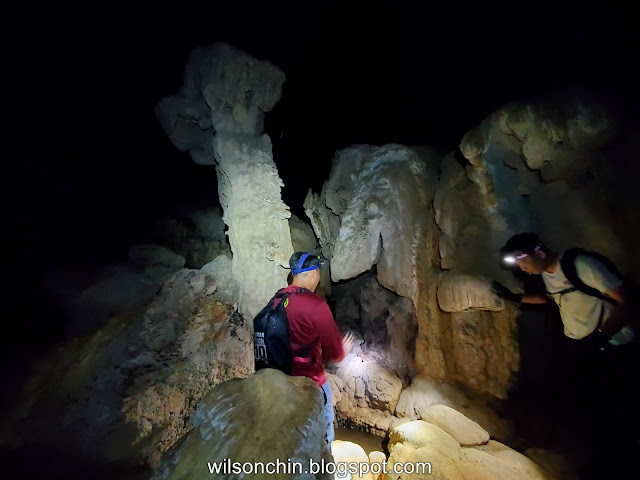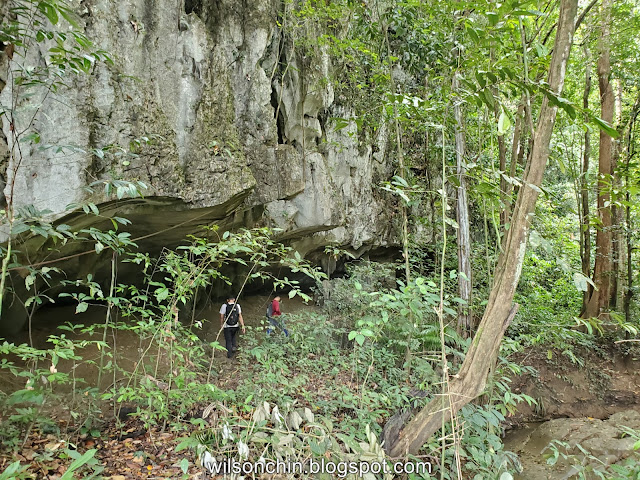How is a cave formed? The limestone mountain that the author
ascended is composed of a type of rock known as sedimentary rock, which is
produced from layers of sediment that amass over time. This sediment is
frequently composed of the shells and skeletons of marine creatures, meaning
that limestone is rich in calcium carbonate.
Over time, somewhat acidic groundwater can dissolve the
calcium carbonate in the rock, forming small fissures and cavities. As the
water flows through the rock, it can produce increasingly larger cavities,
ultimately creating the complex cave systems we witness today.
Upon reaching the bottom of the limestone mountain, we then had to ascend to the lower mid-section of the cave since that’s where the entrance was situated. It was a challenging trek, but it was worth it when we arrived at our destination.
As we entered the cave, we were welcomed by a refreshing
breeze and the sound of water dripping from the stalactites overhead. The cave
was damp and dark, but it was filled with fascinating sights such as
stalagmites and stalactites that appeared to go on eternally. We were also
greeted by a few bats swiftly flying beside us in and out of the cave.
Inside the cave, there were numerous tiny chambers that were interconnected with one another. We spotted many creatures such as bats, flying insects, tarantulas, and crickets. The bats were perched on the ceiling while their guano was beneath them. There were numerous flying insects on the guano since I was wearing a headlight and my face was occasionally targeted by the flying insects, as they attempted to approach the light.
We felt a sense of wonder as we explored the cave’s numerous
chambers. We couldn’t help but marvel at how nature had formed such a stunning
place. The stalactites and stalagmites were akin to works of art that had been
sculpted over thousands of years.
As we proceeded deeper into the cave, we noticed that it was becoming darker and more humid. We could hear the sound of water dripping from overhead and the infrequent fluttering of bat wings.
We continued our exploration through the cave, taking in all
of its sights and sounds. We saw more creatures such as crickets and tarantulas
scurrying along the walls. We also observed that there were numerous types of
rocks and minerals in the cave. Our guide utilized his machete knife to strike
the stalagmites, and surprisingly it sounded like a musical instrument being
played.
Stalactites are formed from the cave's ceiling, where water
drips down and deposits small amounts of calcium carbonate. Over time, these
deposits accumulate, forming the long, thin structures we call stalactites.
Stalagmites, on the other hand, form on the cave's floor.
They grow upwards from the ground as mineral-rich water drips down and deposits
calcium carbonate. Over time, these deposits accumulate into tall, conical
structures that can take hundreds or even thousands of years to form.
There were also several narrow passages that required us to
crawl through them on our hands and knees. Some of the passages were steep,
while others had a sizable drop or required us to climb a few meters up.
In one of the chambers, there was a large hole above it that allowed sunlight to filter through during the afternoon, creating a beam of light that illuminated the cave's interior.
After what felt like hours of exploring, we finally reached
the end of the cave. In my opinion, venturing into a cave like this one is not
just an adventure, but also an opportunity to learn about the fascinating
geological processes that shape our world, as well as the rich ecosystems that
can thrive in even the most inhospitable environments.
 Beyond their geological significance, caves like this one
also have ecological value. Bats, for instance, play an important role in many
cave ecosystems by serving as pollinators and helping to regulate insect
populations. The guano they produce can also provide important nutrients for
other creatures that inhabit the cave.
Beyond their geological significance, caves like this one
also have ecological value. Bats, for instance, play an important role in many
cave ecosystems by serving as pollinators and helping to regulate insect
populations. The guano they produce can also provide important nutrients for
other creatures that inhabit the cave.
Overall, the journey to the cave was an adventure in itself, with lush green surroundings on the outside and the sounds of chirping bats adding to the beauty of the experience. The complex cave systems that we saw were a testament to the fascinating processes that have shaped our world over thousands of years. The awe-inspiring sights, sounds, and creatures that we encountered within the cave only added to the wonder of the experience.
Exploring the cave was an unforgettable experience that gave
us a glimpse into the intricate and fascinating world of nature. It is a
reminder of how small we are in the grand scheme of things and how much there
is to learn and discover in this world.
However, it is important to remember that caves are delicate environments that require our respect and protection. As visitors, it is our responsibility to take care of these natural wonders and leave them as we found them. Let us not take anything but photos, leave nothing but a footprint, and try our best not to touch the stalagmites and stalactites for them to form naturally.
By doing so, we can preserve these magnificent structures
for future generations to enjoy and continue to learn from. Let us take the
time to appreciate and protect the natural wonders that surround us, and let us
always remember to be responsible stewards of the environment.



































